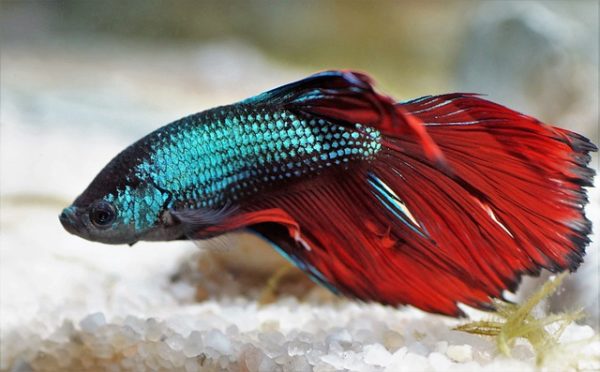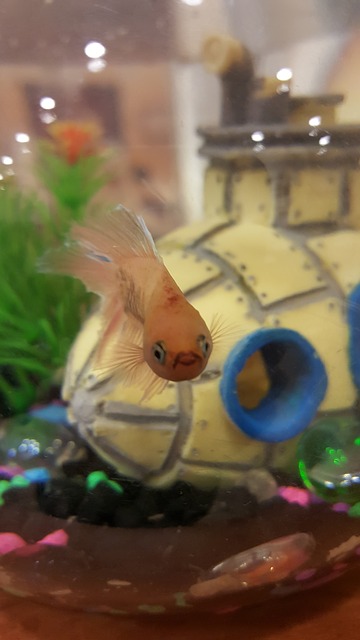Fish diseases are pretty prevalent, especially for smaller fish species like a betta. Amidst all the standard conditions is the swim bladder disease that affects the swim bladder functions in a betta. Often, the disease is caused due to a combination of factors rather than just one.
Besides betta, the swim bladder disease also affects goldfish. Although the condition can be very impactful, it is equally treatable. With the proper treatment at the right time, a betta fish can easily make a full recovery.
This article will explore more about the swim bladder disease in betta, the symptoms, causes, and treatment options.
Table of Contents
What Is the Swim Bladder?

The swim bladder is a functional organ present in almost every bony fish to maintain buoyancy underwater. It is a gas-filled organ that works as an air-inflated balloon. The swim bladder is flexible and can expand and contract depending on the availability of gas inside.
When the swim bladder expands, it reels more air into the organ. The increase in volume displaces more water, maintaining the fish’s buoyancy in the water. So, if you find a fish floating on the water, it is due to this organ.
What Is Swim Bladder Disease?
Swim bladder disease affects the functionality of the swim bladder, disrupting the buoyancy of the fish underwater. The disorder can happen due to poor water conditions, stress, or other undiagnosed causes.
Betta fish species are often affected the most due to this disease, affecting their ability to float or sink. The swim bladder disorder is often a symptom that shows up when the betta is diseased.
Most of the affected bettas feature a bloated belly and are often misdiagnosed with dropsy. So, if you notice something amiss with your betta, make sure they get the correct diagnosis first.
Causes Of Swim Bladder Disease in Bettas

The causes behind the swim bladder disease in Bettas is quite diverse. It can be one condition or a host of causes that leave the fish in a state of constant discomfort. The most common reason is the sudden compression of the swim bladder.
If your betta is somehow overeating or constipating or gasping more than normal air, it can compress the swim bladder in the process. Sometimes, bettas that consume only dried or freeze-dried food also experience this when the food expands in their stomach.
Some of the most common causes include:
Low water temperature
Bettas need an optimal water temperature between 75-80 degrees Fahrenheit. If the temperature is drastically low in the tank, it directly affects digestion. Slowed down digestion contributes to enlargement of the abdominal region, putting pressure on the swim bladder.
Infections
Both parasitic and bacterial infections can cause inflammation in the swim bladder, leading to the disorder. If your betta experiences an injury and contracts an infection in the open wound, it can lead to poor functioning of the swim bladder.
Enlarged abdominal organs
Besides the stomach, a sudden enlargement of the associated abdominal organs in the betta can lead to enhanced risks of swim bladder disease. Some of the common conditions include:
- Cysts in the kidneys
- Fatty depositions in the liver
- Egg binding in the female betta
If you notice a sudden swelling around the abdominal region of the betta, it is a sign of disease. You can either treat them in the tank or separate them for better care.
Congenital conditions
Some bettas are born with birth defects that affect the swim bladder functions. However, this comprises a tiny percentage of the list of causes. Bettas with such conditions die very early.
Sudden shock
If you suddenly change the water temperature or other water parameters, the shock can lead to swim bladder disease. Not just swim bladder, the shock also results in fin clamping, which is another common disorder that affects the fish’s swimming capabilities.
What are the Most Common Symptoms of Swim Bladder Disease in Betta?

Spotting swim bladder disease in your betta can be complex. Most of the symptoms coincide with what you’d experience with dropsy. So, it isn’t surprising that several individuals often misdiagnose the bettas.
That said, there are a handful of common and very telling symptoms worth looking into.
Symptoms Related to Overfeeding/Constipation/Too Much Air
Issues with swimming
Since swim bladder disorder affects buoyancy, you will find the betta hard to swim. Instead of having the support to float around, they will have a hard time moving from the bottom of the substrate to the top. This is a prevalent issue and, hands down, the most prominent symptom.
Lopsided swimming is also a common sign. Bettas, who are generally very active in the tanks, will start swimming on the sides without any direction.
Lack of posture
If you find the betta not sticking to a normal position and swimming in a uniform direction, it is a sign of swim bladder disease. They will start to float or sink to the substrate without any resistance.
Protruding abdomen
A distended or bulging belly is another common sign of swim bladder disease. Besides, the disorder also signifies that the betta has overfed or constipated. However, if you notice that the symptom is persistent with pine coning of the scales, your betta is struggling with dropsy. In that case, remove them from the tank immediately.
Reduced appetite
If you have a chirpy and active betta that has suddenly stopped feeding, they could be struggling with swim bladder disorder. Since the betta has a hard time swimming in harmony, they might not want to swim up to the surface and get their food too.
Fatigue and sluggish motion
Bettas suffering from swim bladder disorder due to overeating or air can show signs of lethargy. Sometimes, an overfed betta has difficulty moving, compressing its swim bladder. Keep an eye if you notice something similar. If the symptoms are persistent, it could be a sign of infection.
Symptoms Related to Parasites and Bacterial Infections
In other cases, the betta could be suffering from something a lot more severe than you anticipate. Parasitic and bacterial infections are common contributors to swim bladder disease. In such cases, you should look out for the following symptoms:
Uncontrollable shaking
It is not common for a betta fish to shake without reason. Overfeeding, paired with infection common, leads to jitters and shakes in the betta.
Clamped fins
Infections can put the betta under a lot of stress. And the easiest way they show signs of stress is by clamping their fins. If you notice this getting worse, immediately remove the diseased betta from the tank. This will prevent the infection from spreading further.
How To Treat Swim Bladder Disease in Bettas?

The swim bladder disease in bettas is treated as per the symptoms. The treatment for overfeeding will differ from that used for treating infections. So, it is ideal that you have an idea of almost every possible treatment option available.
Swim Bladder Disease Caused by Overfeeding
If the betta shows symptoms of swim bladder disease caused by overfeeding, the treatment options are simple. Often, the easiest way to help the fish recover is by letting them fast till they return to their usual self.
Bettas recover pretty quickly if their swim bladder disease is due to overfeeding. Some of the standard treatment options include:
- Start by first removing the diseased betta from the communal tank to a quarantine tank.
- Once done, make your betta fast for at least three days. Simultaneously, increase the water temperature of the tank. The heat will speed up the digestion process, ensuring a quicker recovery.
This should help with the recovery process quite exponentially. In case the symptoms are still prevalent, we’d recommend feeding them live daphnia since it has high fiber content in it.
Swim Bladder Disease Caused by Parasite/Bacterial Infection
While treating the symptoms of overfeeding is simple and quite easily reversible, we can’t say the same for infections. In such cases, you need to take the help of medications to treat the infection once you move it into the isolation tank.
- Depending on the type of infection, there are two types of treatments. If it is a bacterial infection, use melafix. If it is a parasitic infection (which is quite rare), use bettamax.
- Always keep a close eye on the betta after administering the medication. If the fish starts responding to the first medication, avoid adding the second one.
Parasitical infections are very rare and seldom affect the betta. So, always start the treatment with melafix first.
Swim Bladder Disease Caused by Shock
If the swim bladder disease is due to shock, you need to act fast. Check if it is the water temperature or the water composition. You can either increase or decrease the water temperature and switch off the lights depending on the condition. You want to leave the betta to themselves. Don’t poke and prod and just let them be. With the right environment, they should recover on their own.
Epsom Salt for Swim Bladder Disease
Adding Epsom salt can relieve the swim bladder disease in several way. It can relieve signs of constipation and even reduce inflammation in the betta.
Giving your betta an Epsom salt bath can effectively alleviate the symptoms and help with your betta’s recovery. You need to be wary of the concentration of the salt and the duration of the bath.
- Typically, we’d recommend mixing 1 tablespoon of the Epsom salt in half a gallon of tap water and fill the remaining half gallon with the tank water. You can soak the diseased betta in the Epsom salt bath for 10-15 minutes and notice their behavior.
If the fish is still inflamed or constipated, you can take the fish out of the bath and put them back into the original tank. From there, you can monitor the progress.
How To Prevent Swim Bladder Disease?
More than a disease, the swim bladder disorder is more like a symptom. So, you can prevent it from happening or getting worse than it already is.
We’d recommend that you keep a check on the following for optimal prevention:
Feed good-quality food
Since overfeeding is a common cause of swim bladder disease, you need to diet. The poor-quality and significantly cheaper fish food is filled with air and fillers that swell in the stomach. These can lead to poor digestion, constipation, and bloating in the betta.
Soak the food
Flakes and dried foods float on the water surface. Although your betta can feed on the surface, it comes with complications too. When bettas feed on the surface, they gulp down air with the food, leading to bloating in them. Too much air can lead to swim bladder disorder too.
Avoid overfeeding
A betta eating 2-3 pellets per day is enough. Some bettas can even go without food for up to 2 weeks. So, instead of overfeeding them, feed them what they can stomach and digest.
Maintain water quality
Dirty and uncleaned water is a significant contributor to swim bladder disease. Poor water quality leads to risks of infections too. So, every once in a while, you need to clean out the betta’s water tank. Not just the water, clean the ornaments and the plants too.
Regulate the tank’s temperature
Bettas are very sensitive to changes in water temperature. If there are potent fluctuations in the temperature, it will put the betta in shock, leading to risks of swim bladder disease. So, manage the water temperature in the optimal range.
Get rid of aggressive tankmates
Injuries in the betta can lead to swim bladder disorder too. And most often, the injuries are inflicted by other aggressive tank mates. If you find someone causing chaos, immediately pick and separate them from the tank.
Is Swim Bladder Disease Fatal?
The severity of the swim bladder disease in a betta depends on the cause. The causes of overfeeding or excess air are treatable, and the betta recovers quite quickly. However, if the condition is due to an infection, the chances of recovery are pretty unstable.
If you catch the infection or the shock early, it is recoverable. However, if the damage is beyond repair, we’d recommend pulling the diseased fish out of the tank.
Also, if the swim bladder disease is an injury-induced condition, you need to treat the condition just about immediately. Untreated injuries can lead to lacerations and lead to infections that can become fatal later.
Is Swim Bladder Disease Contagious?
The only time that swim bladder disease in bettas is contagious is infection-induced. Bacterial or parasitic infections spread very quickly in the tank. So, if you diagnose the symptoms later, it can lead to complications in the betta and even make the disease contagious.
Conclusion
Swim bladder disease in betta is a widespread disorder. However, diagnosing the condition early is crucial for quicker recovery. We’d recommend that you follow all the ideal steps to prevent this from happening in the first place. Since bettas are prone to infections and injuries, create a safe environment in the tank as much as you can.
We hope this guide gives you all the detailed insights you are looking for. In case of further queries or confusion, feel free to comment below.
